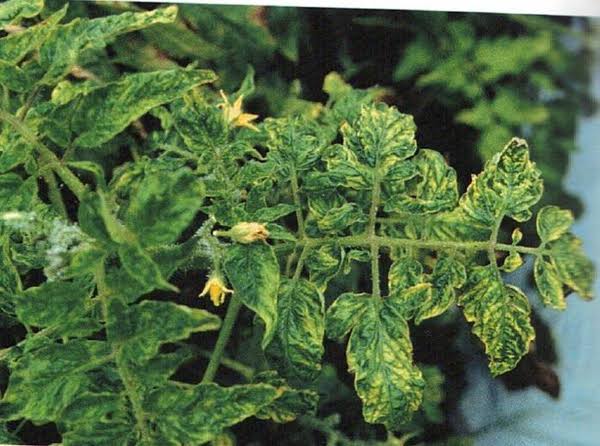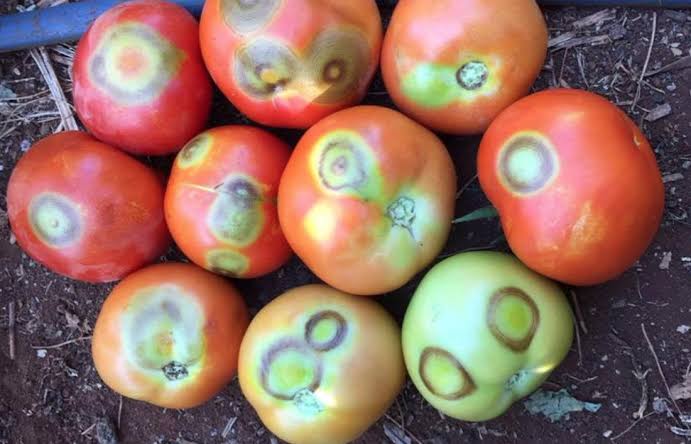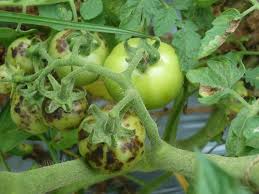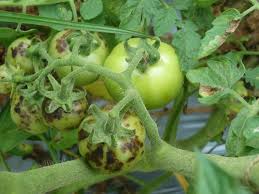Tomato Ringspot Virus, scientifically known as TomRSV, is a plant virus that affects tomatoes and other crops. This microscopic invader belongs to the family Secoviridae and is primarily transmitted by nematodes, tiny worm-like organisms found in soil. Let’s delve into the world of Tomato Ringspot Virus and understand its impact on agriculture.
This viral menace poses a significant threat to tomato crops worldwide. Once infected, tomato plants exhibit a range of symptoms, including yellowing of leaves, stunted growth, and the development of characteristic ringspots on the fruit. These visual cues are telltale signs of the virus’s presence, causing concern among farmers.
The lifecycle of Tomato Ringspot Virus is intricately linked to nematodes, which act as vectors for transmission. These minuscule creatures serve as carriers, transporting the virus from infected plants to healthy ones as they feed on roots. This efficient mode of transmission contributes to the rapid spread of the virus within agricultural settings.
Farmers face a challenging task in managing Tomato Ringspot Virus. Traditional control methods involve the use of resistant tomato varieties, crop rotation, and soil treatments to reduce nematode populations. However, the virus’s ability to persist in soil for extended periods complicates these control efforts, making it a persistent threat to tomato cultivation.
Researchers and agricultural experts continually explore innovative strategies to combat Tomato Ringspot Virus. Biotechnological approaches, such as genetic modification to enhance plant resistance, are under consideration. These efforts aim to develop sustainable solutions that minimize the reliance on chemical pesticides while safeguarding tomato crops from the detrimental effects of the virus.
Its intricate relationship with nematodes, coupled with the challenges of soil persistence, underscores the importance of ongoing research and the development of effective control measures. As agriculture evolves, finding resilient and sustainable solutions to mitigate the impact of Tomato Ringspot Virus remains a priority for ensuring the health and productivity of tomato crops worldwide.
Read Also: How to Farm and Care for Goldstripe Sardinella Fish (Sardinella gibbosa)
Plants Affected by Tomato Ringspot Virus (TomRSV)

Tomato Ringspot Virus (TomRSV) has a broad host range, affecting various plants beyond tomatoes. This viral pathogen is known to infect and impact a wide array of crops and ornamental plants. Some of the notable plants affected by Tomato Ringspot Virus include fruit trees, berries, and ornamental flowers.
1. Fruit Trees: Apple and peach trees are susceptible to Tomato Ringspot Virus. The virus can compromise the health and yield of these fruit-bearing trees, leading to reduced fruit quality and economic losses for orchard owners.
2. Berries: Strawberry plants are among the vulnerable hosts of TomRSV. Infection can result in stunted growth, yellowing of leaves, and a decline in berry production. The impact on berry crops is a concern for farmers aiming to harvest healthy and abundant fruit.
3. Ornamental Flowers: Various ornamental plants, such as roses and lilies, can fall victim to Tomato Ringspot Virus. The aesthetic appeal of these flowers may be compromised, as infected plants may display symptoms like leaf discoloration and distorted growth.
These diverse plant species illustrate the adaptability and wide-ranging impact of Tomato Ringspot Virus within the plant kingdom. The virus’s ability to infect both economically important crops and ornamental plants highlights the need for comprehensive strategies in agriculture and horticulture to manage and mitigate its effects.
As farmers and researchers work together, understanding the range of plants susceptible to TomRSV becomes crucial for developing effective control measures and safeguarding diverse plant communities from this pervasive viral threat.
Damages Caused by Tomato Ringspot Virus

Tomato Ringspot Virus (TomRSV) inflicts significant damages on various plants, affecting both agricultural crops and ornamental plants. The consequences of TomRSV infection include:
1. Reduced Yield: In tomato crops, one of the primary impacts is a decrease in yield. Infected plants may produce fewer and lower-quality fruits, affecting both the quantity and market value of the harvest.
2. Fruit Deformities: Tomato Ringspot Virus can cause distinctive ringspots on the fruit. These blemishes not only diminish the visual appeal of tomatoes but can also render them unsuitable for sale, contributing to economic losses for farmers.
3. Stunted Growth: Infected plants often exhibit stunted growth, affecting their overall vigor and productivity. This symptom is not limited to tomatoes but extends to other susceptible plants, such as fruit trees and berries.
4. Leaf Yellowing and Necrosis: Yellowing of leaves is a common symptom of TomRSV infection. As the virus progresses, leaves may also show necrotic areas, further compromising the plant’s ability to photosynthesize and produce essential nutrients.
5. Root Damage: Tomato Ringspot Virus is transmitted by nematodes, which feed on plant roots. This can lead to root damage, affecting the plant’s ability to absorb water and nutrients from the soil, exacerbating the overall stress on the plant.
6. Spread to Ornamental Plants: Beyond agricultural crops, TomRSV can infect ornamental plants, causing aesthetic damage. Flowers and decorative plants may exhibit distorted growth, leaf discoloration, and reduced ornamental value.
7. Long-Term Soil Persistence: The virus can persist in soil for extended periods, making it challenging for farmers to implement effective control measures. This persistence contributes to the ongoing threat of TomRSV in agricultural settings.
8. Economic Impact: The cumulative effects of reduced yield, lower crop quality, and the potential need for control measures contribute to economic losses for farmers and the agricultural industry as a whole.
Mitigating the damages caused by Tomato Ringspot Virus requires a holistic approach, including the development of resistant plant varieties, effective crop rotation strategies, and sustainable agricultural practices. As researchers continue to explore solutions, understanding the diverse impacts of TomRSV on different plants remains crucial for implementing targeted and efficient control measures.
Read Also: Environmental Factors Affecting Feed Consumption in Fishes
Control and Preventive Measures

Controlling and preventing the spread of Tomato Ringspot Virus (TomRSV) involves a combination of agricultural practices, biological measures, and, in some cases, chemical interventions. Here are some key control and preventive measures:
1. Resistant Plant Varieties: Planting tomato varieties that exhibit resistance to Tomato Ringspot Virus is a fundamental strategy. Breeding programs focus on developing resistant cultivars to reduce the susceptibility of crops to the virus.
2. Crop Rotation: Implementing crop rotation practices helps break the virus’s cycle by interrupting its access to host plants. Farmers can avoid planting susceptible crops, including tomatoes and related species, in the same location consecutively.
3. Nematode Management: Since nematodes serve as vectors for TomRSV transmission, managing nematode populations is crucial. This can be achieved through soil treatments, such as biofumigation or the use of nematicides, to reduce nematode numbers in the soil.
4. Sanitation Practices: Maintaining good hygiene in the field is essential. Removing and destroying infected plants, along with any nearby weeds that may serve as alternative hosts, helps prevent the further spread of the virus.
5. Planting in Nematode-Free Areas: When possible, selecting fields with a history of low nematode populations can help reduce the risk of TomRSV transmission.
6. Biological Controls: Introducing natural enemies of nematodes, such as predatory nematodes or beneficial microorganisms, can help regulate nematode populations and indirectly limit the spread of Tomato Ringspot Virus.
7. Genetic Modification: Research is ongoing to develop genetically modified crops with enhanced resistance to TomRSV. This biotechnological approach aims to provide a sustainable and effective means of controlling the virus.
8. Monitoring and Early Detection: Regularly monitoring crops for symptoms of TomRSV allows for early detection and intervention. Prompt action, such as removing infected plants, can help contain the spread of the virus.
9. Quarantine Measures: Implementing quarantine measures in nurseries and other plant propagation facilities helps prevent the introduction and spread of the virus through infected plant material.
10. Educational Outreach: Providing education and training to farmers on the identification of TomRSV symptoms, preventive measures, and sustainable farming practices contributes to overall disease management.
By combining these strategies, farmers can create a comprehensive approach to control and prevent the impact of Tomato Ringspot Virus on their crops. As agricultural research advances, the development of integrated pest management systems will continue to play a vital role in minimizing the economic and agricultural losses associated with TomRSV.
Frequently Asked Questions (FAQs) About Tomato Ringspot Virus
1. Q: What is Tomato Ringspot Virus?
A: Tomato Ringspot Virus (TomRSV) is a plant virus that affects various crops, including tomatoes. It is transmitted by nematodes and can lead to significant economic losses in agriculture.
2. Q: How is Tomato Ringspot Virus transmitted?
A: The virus is primarily transmitted by nematodes, microscopic worm-like organisms found in soil. Nematodes serve as vectors, carrying the virus from infected plants to healthy ones as they feed on roots.
3. Q: What are the symptoms of TomRSV infection in tomatoes?
A: Symptoms include yellowing of leaves, stunted growth, ringspots on fruit, and overall decline in plant health. Infected tomatoes may exhibit deformities, impacting both yield and quality.
4. Q: Which other plants can be affected by Tomato Ringspot Virus?
A: TomRSV has a broad host range, affecting fruit trees (e.g., apple, peach), berries (e.g., strawberries), and ornamental flowers (e.g., roses, lilies).
5. Q: How can farmers control Tomato Ringspot Virus?
A: Control measures include planting resistant varieties, practicing crop rotation, managing nematode populations, practicing good sanitation, and, in some cases, using biological controls or genetic modification.
6. Q: Can Tomato Ringspot Virus persist in soil?
A: Yes, the virus can persist in soil for extended periods, making it challenging for farmers to control its spread. This persistence underscores the importance of comprehensive management strategies.
7. Q: Are there resistant tomato varieties available?
A: Yes, breeding programs focus on developing tomato varieties with resistance to Tomato Ringspot Virus. Planting resistant cultivars is a key strategy in disease management.
8. Q: What is the economic impact of TomRSV on agriculture?
A: The virus can lead to reduced yield, lower crop quality, and economic losses for farmers. The impact extends beyond tomatoes to other crops, contributing to the overall economic burden on agriculture.
9. Q: Are there ongoing research efforts to combat Tomato Ringspot Virus?
A: Yes, researchers are actively working on various approaches, including genetic modification, to develop sustainable and effective strategies for managing and preventing the spread of TomRSV.
10. Q: How can farmers detect TomRSV early in their crops?
A: Regular monitoring for symptoms such as leaf yellowing, stunted growth, and ringspots on fruit allows for early detection. Farmers should promptly remove and destroy infected plants to prevent further spread.
Read Also: The Concept Of Powerhouse Gym and their Unique Characteristics

